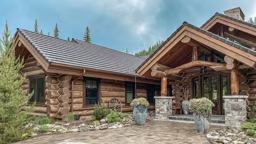
Murray Arnott's job is to squeeze as much livable space out of a home as he can. The award-winning designer serves as principal of Murray Arnott Design Ltd., a Canadian firm that has specialized in designing custom log homes for almost 20 years.
Over the course of his career, Arnott has won a major architectural award for the best 2,500 to 3,500 square foot home in British Columbia, writes a monthly design column and has served as vice president of the International Log Builders' Association. He's also a member of the Log Homes Council and Timber Framers Guild.
LHDI: When designing a smaller log home, are there some considerations you wouldn't have to address with a larger one?
Arnott: In a larger home, you can sometimes end up with a large basement with few necessary and clear uses, resulting in considerable wasted space. In small homes, that is rarely the case. Given that the home has to sit on a foundation, if the soil conditions are favorable, it usually makes sense to turn the foundation into a full basement ? relatively little extra cost for a huge increase in floor area. That ratio starts to change if there is no use for that additional space.
If the main floor has a 3,000 square foot footprint, then it may be difficult to adequately use a 3,000 square foot basement. That is rarely a problem in small homes because the space will undoubtedly be used for necessary uses such as storage or mechanical.
There is not the challenge of having long walls and achieving a sense of intimacy is not as difficult. You also don't have to add things such as recirculation pumps because of the short lengths of hot water supply runs. Central heating tends to be easier.
LHDI: Are there certain sacrifices those who build small homes have to make? On the other hand, are there gains to be had with smaller log homes?
Arnott: The obvious sacrifice is people having to contain themselves to less than desired size of spaces in many cases. There can be less flexibility in design and less room for expansion or special purpose rooms. While these can be seen as sacrifices, in other ways, they can be seen as ways to economize and to be more environmentally responsible.








_11868_2024-09-17_08-44-256x288.avif)


